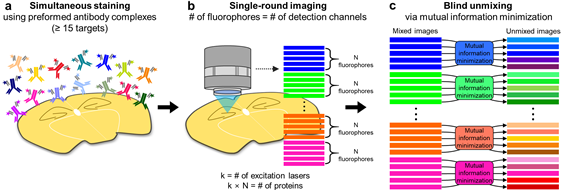
[Prof. Yoon, Young-Gyu, Kim, Jeewon (PH.D candidate), Prof. Chang, Jae-Byum From Left: ]
Recent studies have shown that protein markers in the cancer tissues manifest differently across cancer patients. Related research findings indicate that such a difference determines the cancer progress as well as reactivity to anti-cancer drugs. This is why detecting multiple markers, also known as multiplexed imaging, from cancer tissues is deemed essential.
The research team’s development, PICASSO, is capable of detecting 15 – and at most 20 – protein markers at once via fluorescence imaging. This development was made possible by utilizing fluorophores exhibiting similar emission spectra simultaneously and accurately isolating each type of the fluorophores with blind source separation. Said technique does not require specialized reagent or expensive equipment and is thus considered a promising method of better diagnosis of cancer and drug development as well as protein marker discovery.
EE PH.D student Kim, Jeewon and Materials Science and Engineering student Seo, Junyoung, and alumnus Sim, Yeonbo have led the research as first authors, and their paper was published in Nature Communications, book 13, May as “PICASSO allows ultra-multiplexed fluorescence imaging of spatially overlapping proteins without reference spectra measurement”.
